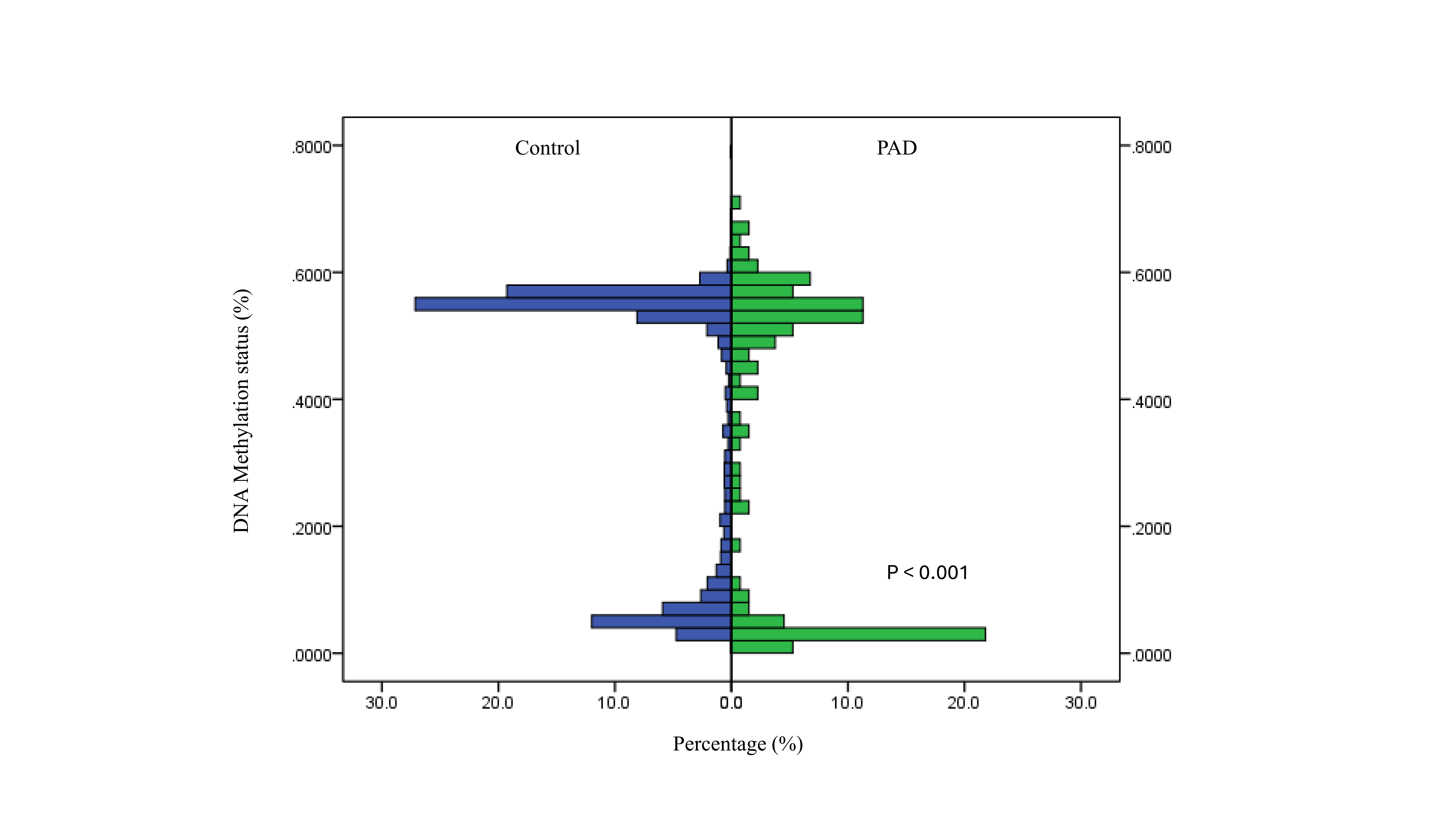Final ID: Sa1116
VTRNA2-1 Promoter Methylation as a Prognostic Biomarker in Peripheral Artery Disease: Implications for Maternal Nutritional Influence
Abstract Body (Do not enter title and authors here): Background
Peripheral artery disease (PAD) is associated with high morbidity and mortality and is closely related to diabetes mellitus (DM) and atherosclerosis. Recent advances in epigenetics have highlighted the critical relationships of non-coding RNA Vault RNA 2-1 (VTRNA2-1) promoter methylation and periconceptional nutritional status. Furthermore, the abundance of methylation of the VTRNA2-1 promoter is associated with glucose metabolism and cell aging. This study investigates the association between VTRNA2-1 promoter methylation and clinical outcomes in PAD patients requiring revascularization.
Hypothesis
VTRNA2-1 promoter methylation status is associated with clinical outcomes in PAD patients requiring revascularization.
Methods
A total of 133 PAD patients requiring revascularization were enrolled. Inclusion criteria included adults over 20 years old, consent to participate, and a requirement for angioplasty. Blood samples were processed to isolate leukocytes, and DNA was extracted using the DNeasy blood kit. Bisulfite pyrosequencing was performed to quantify CpG site-specific DNA methylation at the VTRNA2-1 promoter locus. General population samples from the National Health Research Institutes were used as the control group to compare the methylation status. Patients' one-year clinical outcomes were evaluated.
Results
The study found significant differences in VTRNA2-1 promoter methylation status between PAD patients and the control group (P < 0.001). Hypomethylation of VTRNA2-1 promoter was associated with a higher amputation rate in PAD patients (HR 2.19, 95% CI 1.09-4.42, p=0.027). Among patients without ESRD (N=79), those with hypomethylation had a significantly increased risk of major adverse limb events (MALE) (HR 2.78, 95% CI 1.11-6.97, p=0.024), amputations (HR 2.58, 95% CI 1.02-6.57, p=0.044), and progression to ESRD (p=0.039).
Conclusion
The methylation status of VTRNA2-1 promoter is significantly different between PAD patients and the normal population, with hypomethylation linked to poorer clinical outcomes in PAD patients undergoing revascularization. These findings suggest that VTRNA2-1 promoter methylation status could serve as a valuable biomarker for predicting prognosis and guiding treatment strategies in PAD. Our results open a molecular link between the periconceptional environment and the risks of PAD.
Peripheral artery disease (PAD) is associated with high morbidity and mortality and is closely related to diabetes mellitus (DM) and atherosclerosis. Recent advances in epigenetics have highlighted the critical relationships of non-coding RNA Vault RNA 2-1 (VTRNA2-1) promoter methylation and periconceptional nutritional status. Furthermore, the abundance of methylation of the VTRNA2-1 promoter is associated with glucose metabolism and cell aging. This study investigates the association between VTRNA2-1 promoter methylation and clinical outcomes in PAD patients requiring revascularization.
Hypothesis
VTRNA2-1 promoter methylation status is associated with clinical outcomes in PAD patients requiring revascularization.
Methods
A total of 133 PAD patients requiring revascularization were enrolled. Inclusion criteria included adults over 20 years old, consent to participate, and a requirement for angioplasty. Blood samples were processed to isolate leukocytes, and DNA was extracted using the DNeasy blood kit. Bisulfite pyrosequencing was performed to quantify CpG site-specific DNA methylation at the VTRNA2-1 promoter locus. General population samples from the National Health Research Institutes were used as the control group to compare the methylation status. Patients' one-year clinical outcomes were evaluated.
Results
The study found significant differences in VTRNA2-1 promoter methylation status between PAD patients and the control group (P < 0.001). Hypomethylation of VTRNA2-1 promoter was associated with a higher amputation rate in PAD patients (HR 2.19, 95% CI 1.09-4.42, p=0.027). Among patients without ESRD (N=79), those with hypomethylation had a significantly increased risk of major adverse limb events (MALE) (HR 2.78, 95% CI 1.11-6.97, p=0.024), amputations (HR 2.58, 95% CI 1.02-6.57, p=0.044), and progression to ESRD (p=0.039).
Conclusion
The methylation status of VTRNA2-1 promoter is significantly different between PAD patients and the normal population, with hypomethylation linked to poorer clinical outcomes in PAD patients undergoing revascularization. These findings suggest that VTRNA2-1 promoter methylation status could serve as a valuable biomarker for predicting prognosis and guiding treatment strategies in PAD. Our results open a molecular link between the periconceptional environment and the risks of PAD.
More abstracts on this topic:
A novel method for measuring HDL-bound unconjugated bilirubin using an eel fluorescent protein reveals its association with reduced coronary artery disease
Fujioka Tomoo, Iino Takuya, Toh Ryuji, Harada Amane, Nagao Manabu, Shinohara Masakazu, Ishida Tatsuro, Otake Hiromasa
A Biomarker Based on Aneurysm Wall Enhancement and Blood Gene Expression to Identify Symptomatic Intracranial AneurysmsVeeturi Sricharan, Poppenberg Kerry, Jaikumar Vinay, Pinter Nandor, Levy Elad, Siddiqui Adnan, Tutino Vincent

